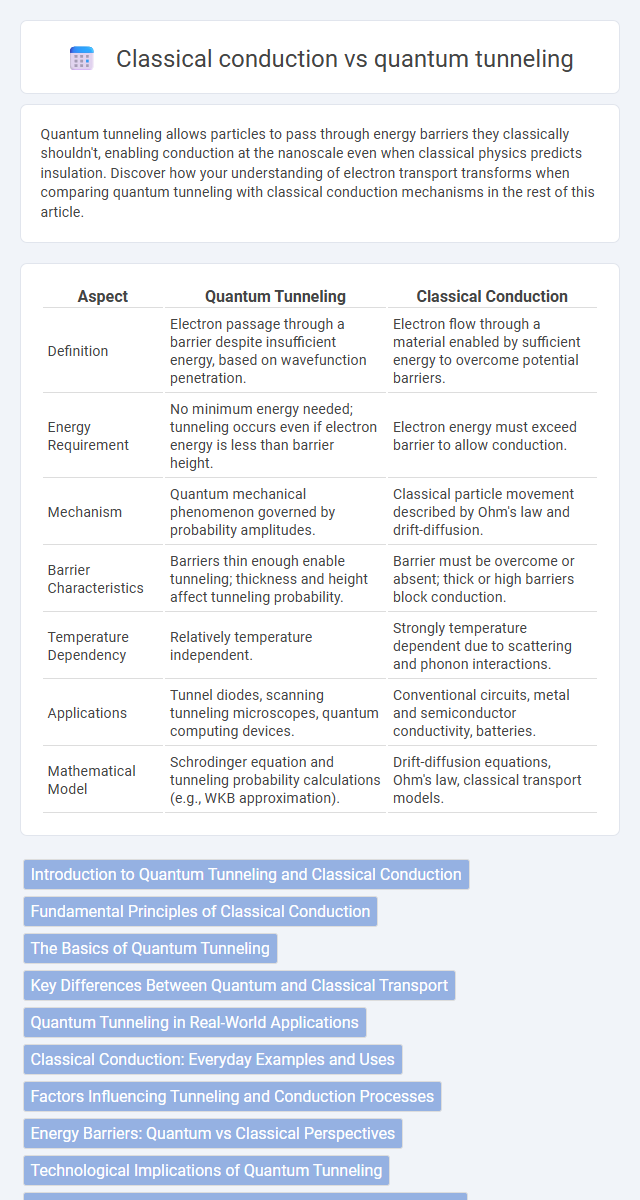Quantum tunneling allows particles to pass through energy barriers they classically shouldn't, enabling conduction at the nanoscale even when classical physics predicts insulation. Discover how your understanding of electron transport transforms when comparing quantum tunneling with classical conduction mechanisms in the rest of this article.
Table of Comparison
| Aspect | Quantum Tunneling | Classical Conduction |
|---|---|---|
| Definition | Electron passage through a barrier despite insufficient energy, based on wavefunction penetration. | Electron flow through a material enabled by sufficient energy to overcome potential barriers. |
| Energy Requirement | No minimum energy needed; tunneling occurs even if electron energy is less than barrier height. | Electron energy must exceed barrier to allow conduction. |
| Mechanism | Quantum mechanical phenomenon governed by probability amplitudes. | Classical particle movement described by Ohm's law and drift-diffusion. |
| Barrier Characteristics | Barriers thin enough enable tunneling; thickness and height affect tunneling probability. | Barrier must be overcome or absent; thick or high barriers block conduction. |
| Temperature Dependency | Relatively temperature independent. | Strongly temperature dependent due to scattering and phonon interactions. |
| Applications | Tunnel diodes, scanning tunneling microscopes, quantum computing devices. | Conventional circuits, metal and semiconductor conductivity, batteries. |
| Mathematical Model | Schrodinger equation and tunneling probability calculations (e.g., WKB approximation). | Drift-diffusion equations, Ohm's law, classical transport models. |
Introduction to Quantum Tunneling and Classical Conduction
Quantum tunneling occurs when particles pass through potential barriers that classical physics deems insurmountable, exploiting their wave-like properties at the nanoscale. In contrast, classical conduction relies on particle motion over conductive paths following Ohm's law, governed by macroscopic electric fields and material resistivity. Quantum tunneling enables electron flow in devices like tunnel diodes and nanoscale transistors, where classical conduction models fail due to quantum mechanical effects dominating charge transport.
Fundamental Principles of Classical Conduction
Classical conduction relies on the movement of charge carriers, such as electrons or ions, through a material due to an applied electric field, following Ohm's Law and temperature-dependent resistivity. The flow is governed by scattering events and collisions that impede carrier mobility, resulting in resistance. Your understanding of classical conduction highlights its dependence on continuous energy states and the absence of quantum effects like tunneling.
The Basics of Quantum Tunneling
Quantum tunneling occurs when particles pass through energy barriers that are insurmountable in classical conduction, enabled by the probabilistic nature of quantum mechanics. Unlike classical conduction that relies on thermal energy to overcome potential barriers, quantum tunneling allows electrons to traverse thin insulating layers even at low temperatures. This phenomenon is fundamental to devices such as tunnel diodes and quantum computing components, where electron wavefunctions penetrate energy barriers, defying classical predictions.
Key Differences Between Quantum and Classical Transport
Quantum tunneling allows particles to pass through energy barriers that are insurmountable in classical conduction, relying on wavefunction probabilities rather than continuous particle trajectories. Classical conduction involves charge carriers moving over potential barriers via thermal energy and drift-diffusion mechanisms, following deterministic paths described by classical physics. The key difference lies in quantum tunneling's non-localized, probabilistic transmission contrasted with classical conduction's localized, energy-dependent transport.
Quantum Tunneling in Real-World Applications
Quantum tunneling enables electrons to pass through energy barriers that are insurmountable in classical conduction, revolutionizing technologies like flash memory, tunnel diodes, and scanning tunneling microscopes. Real-world applications leverage this phenomenon to achieve faster switching speeds, higher data storage density, and nanoscale imaging precision. Your devices benefit from quantum tunneling by gaining enhanced performance and miniaturization beyond classical limitations.
Classical Conduction: Everyday Examples and Uses
Classical conduction occurs when electrons move through a material following an applied electric field, as seen in metals like copper used for electrical wiring and household circuits. This process relies on the drift of free electrons and phonon interactions, enabling efficient current flow in devices like resistors and heaters. Common applications include power transmission lines, electronic circuit boards, and thermal conductors where predictable electron flow governs performance.
Factors Influencing Tunneling and Conduction Processes
Quantum tunneling and classical conduction are influenced by distinct factors rooted in their underlying physics. Tunneling depends heavily on barrier width, height, and particle energy, with thinner and lower energy barriers increasing tunneling probability. Classical conduction is primarily affected by material conductivity, temperature, and carrier concentration, determining the ease with which electrons flow through a conductor.
Energy Barriers: Quantum vs Classical Perspectives
Energy barriers in quantum tunneling are overcome by particles probabilistically passing through potential barriers without needing thermal energy, whereas classical conduction requires particles to possess sufficient energy to surmount these barriers physically. Quantum tunneling allows electrons to transmit through insulating layers thinner than a few nanometers, enabling phenomena like tunnel diodes and quantum computing elements, while classical conduction relies on thermal activation and drift mechanisms over energy barriers. Your understanding of electronic transport must incorporate the quantum perspective to accurately model behavior at nanoscale dimensions where classical theories fail.
Technological Implications of Quantum Tunneling
Quantum tunneling enables electrons to pass through energy barriers that would be insurmountable in classical conduction, thereby revolutionizing the design of nanoscale electronic devices such as tunnel diodes and quantum dots. This phenomenon allows for faster switching speeds and lower power consumption, essential for advancements in quantum computing and ultra-dense memory storage. Understanding quantum tunneling helps optimize your semiconductor components, pushing the boundaries of miniaturization and performance beyond classical limitations.
Future Perspectives: Bridging Quantum and Classical Worlds
Quantum tunneling enables electrons to pass through energy barriers that classical conduction cannot surmount, offering unprecedented opportunities for nanoelectronics and quantum computing. Advances in materials science and nanoscale engineering are expected to integrate quantum tunneling effects into classical conduction frameworks, enhancing device efficiency and speed. Your ability to leverage this convergence could revolutionize future semiconductor technologies and energy-efficient circuits.
quantum tunneling vs classical conduction Infographic

 electrown.com
electrown.com